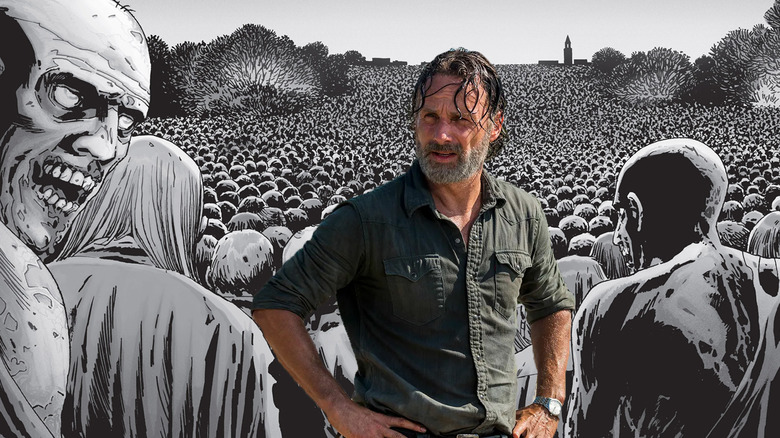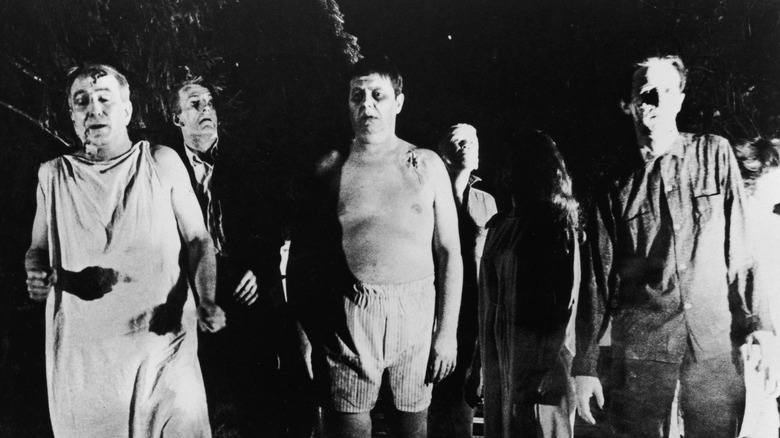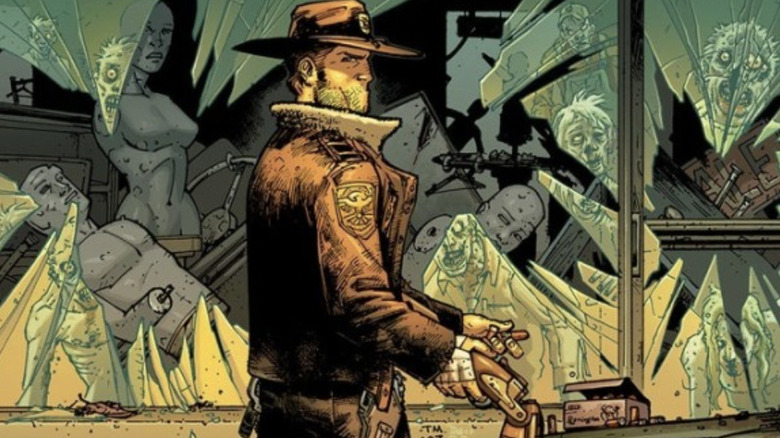Why The Walking Dead Comics Are In Black And White, Explained
We may receive a commission on purchases made from links.
There's a lot to compare about "The Walking Dead" TV series and the original comics by writer Robert Kirkman and artist Tony Moore. (Moore was replaced by Charlie Adlard after issue #6, who stayed on for the rest of the run.) The show has many completely original storylines and characters, like the fan favorite and now star of his own series, Daryl Dixon (Norman Reedus). Some characters die much earlier in "The Walking Dead" TV show than they did in the comics, while some last longer. But another big difference is a matter of presentation.
"The Walking Dead" aired in full-color, like how you'd expect a 2010 television series to do. The comic, though, was colored in black-and-white. As a nod to this, a black-and-white edition of the series' pilot "Days Gone Bye" was made, and "The Walking Dead" season 6 premiere included some scenes shot in black-and-white.
Black-and-white comics are far from unheard of; in manga like "Blade of the Immortal," for instance, black-and-white is the rule, not the exception. But the greyscale of "The Walking Dead" looks less like the striking high-contrast of light and dark in a manga, and more like a world drained of color. Basically, it looks like a black-and-white film — with good reason, because such a film is exactly what the comic is supposed to look like.
Like every modern zombie story, "The Walking Dead" is playing in a sandbox that filmmaker George Romero built with his 1968 film, "Night of the Living Dead." Kirkman considers that film "the most sophisticated zombie movie," so much so that he and Moore originally meant to set "The Walking Dead" in the same world as the movie. The (non-canon) pilot issue of "The Walking Dead" features Rick and Lori Grimes watching news on the zombie outbreak on a '60s television. As argued by Brian Cronin at CBR, that detail places the comic within the same timeframe as "Night."
"Night of the Living Dead" is in public domain due to a copyright error, but Kirkman and Moore decided to "do something completely different," including moving the comic to a contemporary setting. While "The Walking Dead" no longer shared a world with the film, Kirkman and Moore decided to keep the series in black-and-white.
"You could get away with more gore [in black-and-white]," Kirkman explained. "It's not all bloody and violent with red all over the page, so it seems a little less offensive. It's also a little cheaper to print."
The Walking Dead is in black and white as a nod to Night of the Living Dead
In 1968, color films were widely made, so even then Romero shooting "Night" in black-and-white was a retrograde choice. Romero's use of 35mm black-and-white film is often cited as a matter of cost-saving (the production budget for "Night" was reportedly somewhere between $100,000 to $125,000). It's also been written that Romero thought the lack of full color would hide other cost-cutting; Bosco chocolate syrup can pass as dark red blood on black-and-white film.
Even without full-on bloody guts, the violence and depiction of cannibalism in "Night of the Living Dead" sparked controversy. When "The Walking Dead" debuted in 2003, people were much more desensitized to media violence than in 1968. (All the zombie movies that came out in the interim helped.) Still, Kirkman decided to play it safe — including with some of the frugality Romero showed when making "Night."
Romero's later zombie films, most famously "Dawn of the Dead" and "Day of the Dead," were filmed in color. However, some argue the black-and-white palette of "Night" is still the more effective choice, red blood or not. In "Nightmares in Red, White and Blue: The Evolution of the American Horror Film," author Joseph Maddrey writes:
"Because 'Night of the Living Dead' was filmed guerrilla-style in black-and-white, with the unflinching authority of a wartime newsreel, it seems as much like a documentary on the loss of social stability as an exploitation film."
The newsreel feel of "Night of the Living Dead" is also suggested through the characters literally watching the news about the calamity they're living. The broadcast scenes are not pure exposition, but also suggest a much larger outbreak across the U.S. and a national panic surrounding the confinement of the story we're following. Thanks to the news scenes, you can forget that the primary characters never leave the farmhouse once they get there.
The Walking Dead Deluxe reprints the comics in full color
While Romero didn't have the means on "Night of the Living Dead" to show a full-scale epidemic, "The Walking Dead" sure did. The conceit of the comic is it's a zombie movie that doesn't end, not even when the characters escape from danger. Instead, there are more and more challenges to follow the characters through.
Like in Romero's films, the zombies in "The Walking Dead" are there mostly to spark conflict between the living characters. Under extreme circumstances in a world gone mad, people can become monsters in ways that they never expected. When "The Walking Dead" did end, it was when the characters had rebuilt a sustainable and zombie-resistant civilization. The world isn't exactly the same way it was before, but everyday life isn't a struggle to survive like it was when the dead first rose. The typical zombie movie story, as defined by "Night of the Living Dead," is about how people react to the end of one civilization, so "The Walking Dead" could only be completed by the characters building a new civilization.
If you want to experience that long, long journey, you've got another option besides "The Walking Dead" TV show and original comics. That would be "The Walking Dead Deluxe," which reprints the comic, issue-by-issue, but now in full color. ("The Walking Dead Deluxe" is currently up to issue #111.) "Night of the Living Dead" too has been colorized in the past, but I think that sucks up most of the true black-and-white version's atmosphere. "The Walking Dead Deluxe" similarly feels like a novelty, targeted at pre-existing fans who've wondered what their favorite pages would look like in color. But the images weren't drawn to be in full color, and they're most effective without it.
"Deluxe" or not, the best way to read "The Walking Dead" for at least the first time is in its original black-and-white coloring.


